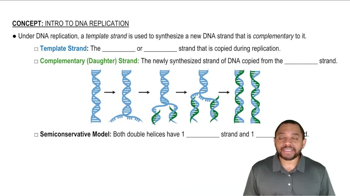Here are the essential concepts you must grasp in order to answer the question correctly.
Melting Temperature (Tm)
The melting temperature (Tm) of DNA is the temperature at which half of the DNA strands are in the double-helix state and half are in the 'melted' single-strand state. Tm is influenced by the length of the DNA strands and their nucleotide composition, particularly the number of guanine-cytosine (GC) pairs, which form three hydrogen bonds compared to the two formed by adenine-thymine (AT) pairs.
Recommended video:
Temperature (Simplified) Example 2
DNA Strand Length
Longer DNA strands have more base pairs, which increases the number of hydrogen bonds holding the two strands together. As a result, more energy (in the form of heat) is required to break these bonds and separate the strands, leading to a higher melting temperature for longer DNA compared to shorter strands.
Recommended video:
Intro to DNA Replication Concept 1
Hydrogen Bonding
Hydrogen bonds are weak interactions that occur between complementary base pairs in DNA. The stability of the double helix is significantly affected by the number of GC pairs, which contribute more hydrogen bonds than AT pairs. Therefore, the overall stability and melting temperature of DNA are higher when there are more GC pairs, especially in longer strands.
Recommended video:
Hydrogenation Reactions Concept 1




